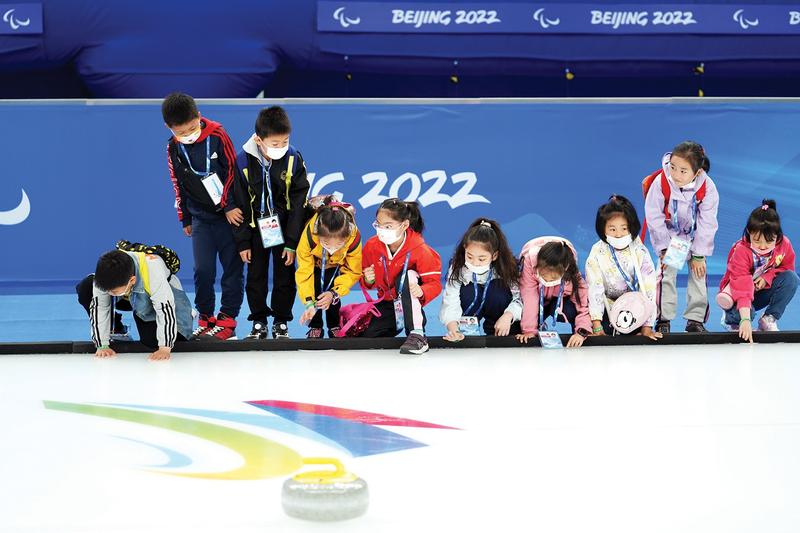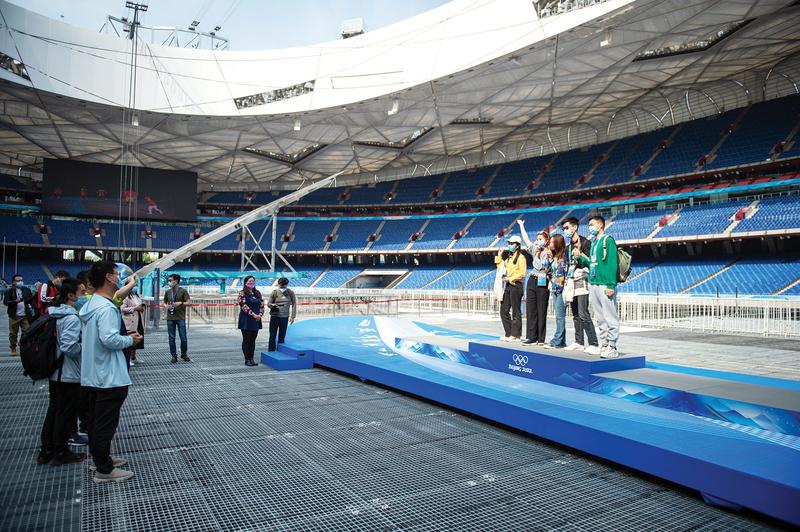 Children get a close-up look and feel of the curling lanes at the Ice Cube on April 16.
The ice sheets used during Beijing 2022 have been retained in the venue’s competition hall. (PHOTO / XINHUA)
Children get a close-up look and feel of the curling lanes at the Ice Cube on April 16.
The ice sheets used during Beijing 2022 have been retained in the venue’s competition hall. (PHOTO / XINHUA)
Fancy spending a day in an Olympian’s shoes? Visitors to Beijing 2022’s stunning venues will be able to do just that with the launch of authentic Winter Games experiences.
With access to competition tracks, a skyline gondola, the athletes’ village and canteens all included, the Yanqing Olympic Park in Beijing’s northwestern suburb is all set to welcome visitors from April 29. The owners expect to build the venue cluster into a hit destination for not just winter sports but also outdoor leisure activities.
The park, which includes the National Alpine Skiing Center and National Sliding Center, launched its official ticketing system on April 24.
A full package, including a round-trip gondola ticket to the top of the mountain and a buffet in the athletes’ dining hall, is priced at 280 yuan (about $43).
Even without snow, the Alpine skiing center offers stunning views from the start gate where the world’s best skiers launched their high-speed glory bids during February’s Winter Games. A “roof walk” experience along the 1.9-kilometer track at the sliding center also promises to thrill visitors during the May Day holiday, which lasts from April 30 to May 4.
“We’ve tried to maintain the whole Olympic atmosphere as much as possible so that visitors can have almost the same experience as athletes had and enjoyed during the Games,” said Fu Liansheng, president of the National Alpine Skiing Center operation company.
 Visitors pose on the podium at the Bird’s Nest on April 20. The stadium staged the opening and closing ceremonies of the Beijing 2022 Winter Olympics and Paralympics. (PHOTO / XINHUA)
Visitors pose on the podium at the Bird’s Nest on April 20. The stadium staged the opening and closing ceremonies of the Beijing 2022 Winter Olympics and Paralympics. (PHOTO / XINHUA)
The company, an affiliate of venue owner Beijing Enterprises Group, will work with the local government, resort developers, and skiing and snowboarding’s international governing body to further develop the center into a commercial destination. The center will continue to bid to host more international events and open its lower, less-technical courses to amateurs, according to Fu.
The athletes’ village, which was built hillside next to the sliding center and accommodated about 1,200 athletes and officials during the Olympics, has been redecorated into a mountain hotel available for booking on major online travel platforms. The dining hall at the village will continue to serve the same healthy menu that athletes enjoyed during the Games, featuring international and traditional Chinese flavors.
“It’s important that the center reminds everyone right away that it is an Olympic venue and it sticks to the highest standards,” Fu said.
Two of Beijing 2022’s ice sports venues — the National Speed Skating Oval and the National Aquatics Center — in the capital’s downtown area carried out trial runs to prepare for their official public openings during the May Day holiday.
As one of three Summer Olympic venues reused for competitions during the Winter Games, the National Aquatics Center, also known as the Water Cube, was transformed into an Ice Cube for curling and wheelchair curling events at Beijing 2022 after hosting swimming and diving at Beijing 2008.
The reversible transformation project — which involved filling the swimming pool with steel structures to support an ice surface above — turned the arena into a multifunctional venue capable of switching from aquatic to ice sports.
 Beijing 2022 souvenirs are displayed for sale at the National Aquatics Center, aka the Ice Cube. (PHOTO / XINHUA)
Beijing 2022 souvenirs are displayed for sale at the National Aquatics Center, aka the Ice Cube. (PHOTO / XINHUA)
The ice sheets used during the Games remain in the competition hall and will be maintained for a month for visitors to learn and experience fundamentals of curling, according to Yang Qiyong, general manager of the aquatics center.
All the visual elements of Beijing 2022, including the setup of the locker rooms, have also been retained, said Yang.
“An authentic Olympic experience will be on offer for the public,” Yang added. “We want people to enjoy a truly immersive Games experience, and allow them to learn more about curling.”
The center will revert to swimming-pool mode in the summer before shifting back to an ice venue ahead of the winter season to host more international curling events.
The World Curling Federation plans to introduce more of its elite-level events to the center and develop the venue’s underground rink into a “World Curling Academy Training Center”, according to Kate Caithness, president of the WCF.
To the north of the aquatics center, the newly built speed skating oval, aka the “Ice Ribbon” due to its sleek design, had its post-Olympic operation tested at a special event where guests were invited to experience the cutting-edge building.
As the world’s first speed skating venue of its size to use carbon dioxide as a clean and efficient refrigerant, instead of the harmful substance Freon, the Ice Ribbon will open its 400-meter Olympic-standard ice track to the public during the May Day holiday.
The venue boasts a 12,000-square-meter full-size ice surface — the largest of its kind in Asia — and will host a variety of sports and leisure activities, including speed skating, figure skating, curling and hockey, to diversify its business operations, according to property owner Beijing State-owned Assets Management Co Ltd.


